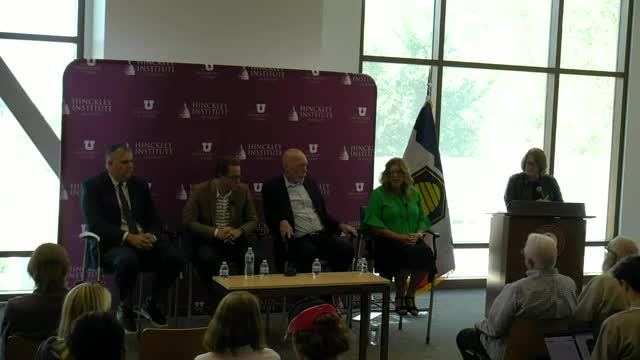Lawmakers clash over education funding amid constitutional amendment debate
September 20, 2024 | Hinckley Institute of Politics, Utah Lobbyist / NGO, Utah Legislative Branch, Utah
This article was created by AI summarizing key points discussed. AI makes mistakes, so for full details and context, please refer to the video of the full meeting. Please report any errors so we can fix them. Report an error »

In a recent government meeting, discussions centered around a proposed constitutional amendment that would remove the earmark protecting public education funding in Utah. Proponents of the amendment, including representatives from the Utah Taxpayers Association, argue that it would provide greater flexibility in budgeting, allowing elected officials to allocate funds based on current needs rather than being restricted by earmarks. They assert that this change could lead to a more efficient use of taxpayer dollars, particularly in light of rising food costs, as the amendment also proposes a reduction in the state sales tax on food.
Billy Hesterman from the Taxpayers Association emphasized the importance of allowing legislators to prioritize funding where it is most needed, suggesting that education would remain a top priority despite the removal of the earmark. He pointed out that many states without similar constitutional mandates successfully fund their education systems.
Conversely, opponents, including Moe Hickey from Voices for Utah Children, expressed concerns about the potential negative impact on education funding. Hickey highlighted Utah's historically low per-pupil funding, ranking 49th in the nation, and warned that removing the earmark could exacerbate existing funding challenges. He noted that there are significant unmet needs in the state, amounting to billions of dollars, and questioned whether legislators could be trusted to maintain education funding without the constitutional protection.
Kevin Green from Americans for Prosperity echoed the sentiment that the amendment would not harm education funding, citing a trigger bill designed to maintain current funding levels even with declining student enrollment. However, critics like Renee Pinkney, president of the Utah Education Association, argued that the lack of explicit \"hold harmless\" language in the amendment raises concerns about future funding stability. She pointed out that legislative changes could easily undermine any assurances made regarding education funding.
The debate highlighted a fundamental tension between fiscal flexibility and the need for stable, reliable funding for education. As the meeting concluded, it was clear that the proposed amendment would have significant implications for Utah's education system, prompting further discussions on how best to balance budgetary freedom with the necessity of protecting essential services like public education.
Billy Hesterman from the Taxpayers Association emphasized the importance of allowing legislators to prioritize funding where it is most needed, suggesting that education would remain a top priority despite the removal of the earmark. He pointed out that many states without similar constitutional mandates successfully fund their education systems.
Conversely, opponents, including Moe Hickey from Voices for Utah Children, expressed concerns about the potential negative impact on education funding. Hickey highlighted Utah's historically low per-pupil funding, ranking 49th in the nation, and warned that removing the earmark could exacerbate existing funding challenges. He noted that there are significant unmet needs in the state, amounting to billions of dollars, and questioned whether legislators could be trusted to maintain education funding without the constitutional protection.
Kevin Green from Americans for Prosperity echoed the sentiment that the amendment would not harm education funding, citing a trigger bill designed to maintain current funding levels even with declining student enrollment. However, critics like Renee Pinkney, president of the Utah Education Association, argued that the lack of explicit \"hold harmless\" language in the amendment raises concerns about future funding stability. She pointed out that legislative changes could easily undermine any assurances made regarding education funding.
The debate highlighted a fundamental tension between fiscal flexibility and the need for stable, reliable funding for education. As the meeting concluded, it was clear that the proposed amendment would have significant implications for Utah's education system, prompting further discussions on how best to balance budgetary freedom with the necessity of protecting essential services like public education.
View full meeting
This article is based on a recent meeting—watch the full video and explore the complete transcript for deeper insights into the discussion.
View full meeting

